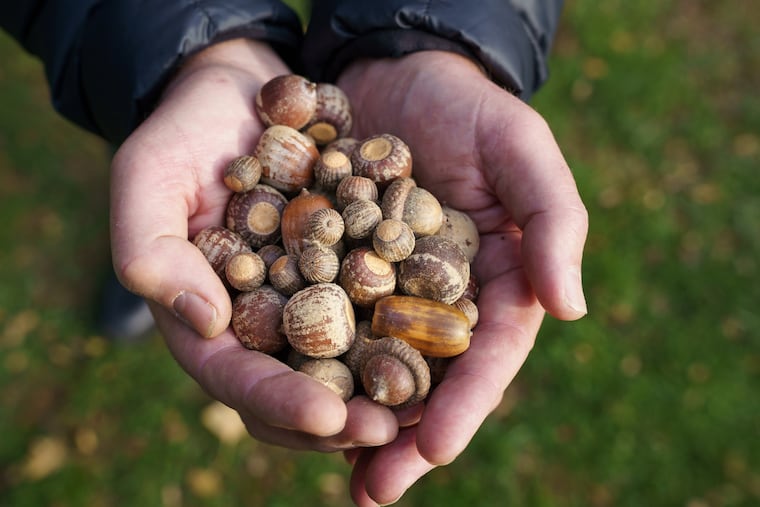Attack of the acorns: Weather, chaos, or a vast oak conspiracy?
Acorn fallout varies radically from year to year.

Jason Parker has witnessed the fallen masses, and so have his customers.
“We have noticed quite a crop of acorns this fall,” said Parker, district manager for the Davey Tree Expert Co. branch in Horsham.
That evidently has been the case regionwide and in other parts of the country. Why? One popular hypothesis among experts is that we are witnessing a vast conspiracy of the oaks.
Turns out that acorns aren’t merely the seedlings of future generations of oaks. Those enigmatic ovular nuts — the equivalent of filet mignon and buttered lobster tail for deer and other animals — represent the seeds of a fascinating cosmic enigma.
It appears to involve weather, the limits of oaken energy, and plain randomness. Acorn output varies dramatically from year to year. Sometimes the oaks can’t stop dropping them. Other years, they are stingy, confounding predators and giving an assist to hunters.
The acorn and its venerable parents continue to intrigue those who study them. How best to describe the seemingly erratic reproductive behavior of the oak?
“It’s very crazy,” said Cathryn H. Greenberg, research scientist with the U.S. Forest Service.
She was among those who addressed a question posed by a reader (obviously an aspiring punster) through The Inquirer’s “Curious Philly” portal: “Why are Philadelphia-area oak trees producing so many acorns this year? I am not kidding, there are mountains of them. It’s nutty!”
So just how many have fallen this year, and how does that compare with other years?
Probably trillions, although no one has counted precisely, for a variety of reasons beyond the sheer volume. The Philadelphia region alone has tens of millions of oaks, said Ryan Reed, natural resource specialist with Pennsylvania’s Department of Conservation and Natural Resources. Each can shed tens of thousands of acorns.
Once they fall, they can disappear quicker than free hot dogs at a baseball game. Deer, mice, and other mammals and birds love them.
The preponderance of available evidence, however, including surveys by the Ohio Division of Natural Resources and the Pennsylvania Game Commission, support the case that this has been a decent harvest season.
“I think there is consensus that this is a big year for acorns,” said Bill Cullina, executive director of the University of Pennsylvania’s Morris Arboretum in Chestnut Hill.
Why would this year be any different?
“There can be tremendous variations in the numbers of acorns you see from year to year,” said Gary Norman, wildlife biologist with the Virginia Department of Game and Inland Fisheries.
That’s the result of “masting,” in which certain tree and plant species vary their seed production in sync.
In the case of oaks, that synchronicity can involve millions of trees over thousands of square miles in given areas, said Walt Koenig, a Cornell University scientist stationed in California.
This gets complicated. Oaks come in a tremendous variety of species. Marc Abrams, a professor and forestry expert at Pennsylvania State University, says the Philadelphia region is home to about 10 of them.
They are roughly divided between red and white oaks. The reds drop their acorns in two-year cycles; the whites, annually. And that can vary within individual species. Evidently, this has been a mast year for a lot of the reds. But not so much for the whites, and Reed suspects that was because of the heavy spring rains that kept down the flight of pollen.
» READ MORE: Why is it raining so much? Twisters, downpours, iPhone alerts: the harvest of a wild spring.
The fact that so many trees in a given area behave similarly suggests that weather in earlier seasons affects acorn production.
But it is hardly the only theory, and one prime suspect is a mouthful called the Predator Satiation Hypothesis, or PSH.
The Predator Satiation what?
In plain English, that would be the fool-the-consumers theory.
Perhaps oaks work in concert to stagger their efforts, to keep the deer, rodents, and birds guessing. If the predators come back after a year of bounty and find that the restaurants are closed for the season, they’ll look elsewhere, and that would give the oaks’ progeny a better shot of surviving the next time around.
Abrams thinks PSH might be the best explanation for acorn variability, and he has a lot of expert company.
Whatever the oaks are up to, their behavior is of significance to hunters, which is why the Game Commission keeps track of acorn production. A lull year for acorns can be a boom year for hunters, according to Greenberg and Norman.
“When acorn crops fail,” they wrote in a recent paper, “wildlife search forests and fields for other food sources which makes game easier for hunters to find and increasing hunter odds of success.”
» READ MORE: Philly's moon tree came from a seed taken aboard Apollo 14. Where is it now?
» READ MORE: ‘Historic Tree’ sign on City Avenue that leads nowhere stumps Philadelphians
Can 40-foot-tall hunks of wood actually conspire with millions of their comrades?
The oaks aren’t talking.
But the natural world has no shortage of remarkable survival strategies. In the meantime, Koenig suggests enjoying the intrigue.
“Don’t take those acorns for granted,” he wrote in a paper he coauthored and published in the American Scientist some years back. “The fact that they are everywhere, or nowhere, as the case may be, illustrates one of the more spectacular ecological mysteries that you’ll encounter as you walk through the woods.”